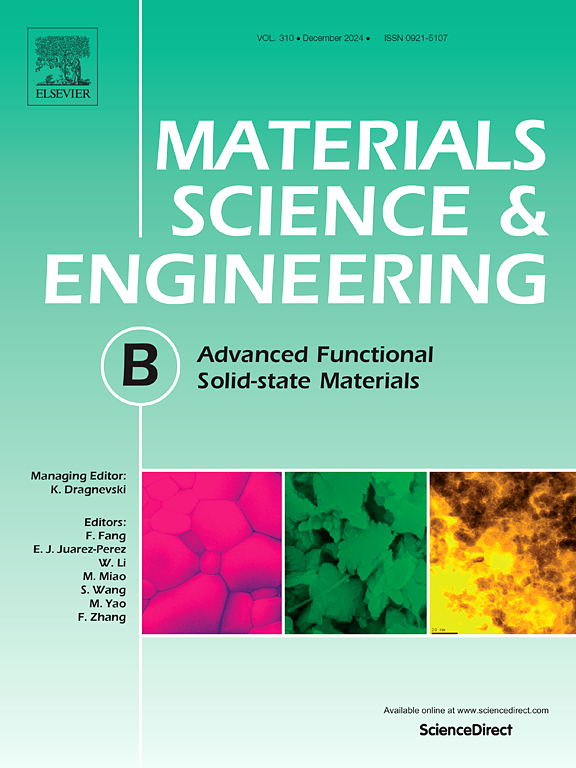用于集成紫外线屏蔽和自供电能源系统的镨掺杂BiPO4/PVA杂化纳米复合材料
IF 4.6
3区 材料科学
Q2 MATERIALS SCIENCE, MULTIDISCIPLINARY
引用次数: 0
摘要
这项工作报道了Pr3+掺杂的BiPO4 (PBP)纳米颗粒嵌入聚乙烯醇(PVA)基质中,用于制造摩擦电纳米发电机(TENG)应用的功能纳米复合材料(PBP@PVA)。通过水热法合成PBP纳米颗粒,并通过不同的负载(0.0、0.5、1.0、2.0、4.0 wt/wt%)的溶液铸造加入到PVA中。x射线衍射证实其为单斜结构(空间群P21/n),扫描电镜(SEM)和透射电镜(TEM)显示其为均匀的棒状结构。通过能量色散x射线光谱验证了PBP的元素组成和分布,FTIR分析证实了PBP与PVA基体之间的相互作用。使用接触角测量的润湿性分析表明纳米颗粒掺入后表面能发生了变化。差示扫描量热法(DSC)表明纳米复合材料的热稳定性增强。光学研究表明,该材料的紫外吸收范围从215 nm (PBP NPs)到238 nm (PBP@PVA),在PBP含量为4.0 wt%时,直接带隙从5.30 eV(纯PVA)降低到5.08 eV。基于纳米复合材料的TENG实现了59µa电流和282 V电压的峰值输出,优于原始PVA。收集的能量足以为28个led供电,为电容器充电,并操作一个数字手表。结果表明,PBP@PVA纳米复合材料具有增强的摩擦电性能和改进的光电性能,支持其在自供电电子系统中的应用。本文章由计算机程序翻译,如有差异,请以英文原文为准。
Praseodymium-doped BiPO4/PVA hybrid nanocomposites for integrated UV shielding and self-powered energy systems
This work reports the development of Pr3+ doped BiPO4 (PBP) nanoparticles embedded in a polyvinyl alcohol (PVA) matrix to fabricate functional nanocomposites (PBP@PVA) for triboelectric nanogenerator (TENG) applications. PBP nanoparticles were synthesized via hydrothermal method and incorporated into PVA through solution casting with varying loadings (0.0, 0.5, 1.0, 2.0, 4.0 wt/wt%). X-ray diffraction confirmed monoclinic structure (space group P21/n), and scanning electron microscopy (SEM) and transmission electron microscopy (TEM) revealed uniform rod-shaped morphologies. Elemental composition and distribution was verified by energy-dispersive X-ray spectroscopy, and FTIR analysis demonstrated interaction between PBP and the PVA matrix. Wettability analysis using contact angle measurements indicated modified surface energy upon nanoparticle incorporation. Differential Scanning Calorimetry (DSC) showed increased thermal stability of the nanocomposites. Optical studies revealed a UV absorption from 215 nm (PBP NPs) to 238 nm (PBP@PVA), along with a systematic reduction in the direct band gap from 5.30 eV (pure PVA) to 5.08 eV at 4.0 wt% PBP content. The nanocomposite-based TENG achieved a peak output of 59 µA current and 282 V voltage, outperforming pristine PVA. The harvested energy was sufficient to power 28 LEDs, charge capacitors, and operate a digital watch. The results demonstrate that PBP@PVA nanocomposites exhibit enhanced triboelectric performance and improved optoelectronic properties, supporting their application in self-powered electronic systems.
求助全文
通过发布文献求助,成功后即可免费获取论文全文。
去求助
来源期刊

Materials Science and Engineering: B
工程技术-材料科学:综合
CiteScore
5.60
自引率
2.80%
发文量
481
审稿时长
3.5 months
期刊介绍:
The journal provides an international medium for the publication of theoretical and experimental studies and reviews related to the electronic, electrochemical, ionic, magnetic, optical, and biosensing properties of solid state materials in bulk, thin film and particulate forms. Papers dealing with synthesis, processing, characterization, structure, physical properties and computational aspects of nano-crystalline, crystalline, amorphous and glassy forms of ceramics, semiconductors, layered insertion compounds, low-dimensional compounds and systems, fast-ion conductors, polymers and dielectrics are viewed as suitable for publication. Articles focused on nano-structured aspects of these advanced solid-state materials will also be considered suitable.
 求助内容:
求助内容: 应助结果提醒方式:
应助结果提醒方式:


